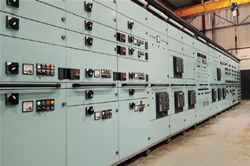Introduction: At many events in which the IET participate, such as the ELEX and InterBuild shows, questions are asked about standards to which hand-wired electrical control panels are to comply. This article looks at types and forms of electrical panels, uses, competency and the standards to which they are to comply.

Electrical panels come in many shapes and sizes (of course) and have many applications. Consider a simple empty box which is then firmly fixed to the ground or building structure, adapted to enclose electrical equipment and terminations to perform a particular function - the empty box becomes an electrical panel and issues relating to electrical safety are to be considered.
Factory built panels and Forms of Electrical Separation
BS EN 60439-1:1999 gives guidance on the forms of separation applicable to factory-built switchgear and controlgear assemblies (switchboards, motor control centres, distribution boards, busbar trunking systems, etc.), known as type-tested and partially type-tested assemblies. These forms of separation provide protection against contact with live parts ( known as basic protection) belonging to adjacent devices and protection from the probability of initiating arcing faults and the passage of foreign bodies between units of the assembly. The Standard also gives guidance on other requirements for protection against electric shock.
Four forms of separation are indicated in the main text of BS EN 60439-1:1999 but there is no specific detail given on how these forms are to be achieved. It is stated in the Standard that the form of separation should be agreed between manufacturer and designer/user. It shall be remembered that higher forms of separation specified will increase costs but will give better operational flexibility regarding safe working when connecting in additional circuits or carrying out maintenance. This ‘trade-off’ must be carefully assessed. The four forms given have basic definitions and applications but Forms 2 to 4 can be further subdivided into more specific ‘Types’ (applications) by discussion and agreement with manufacturers.
Form 1
This form provides for an enclosure to provide protection against direct contact with live parts but does not provide any internal separation of switching, isolation or control items or terminations. These overall assemblies are often known as ‘wardrobe’ type with large front opening doors, usually with an integral doorinterlocked isolator. Operating the isolator interrupts all functions but allows the door to be opened to gain access to the assembly for installation or maintenance. Such assemblies normally have lower fault withstand and it may be inconvenient to shut down a whole plant or system for a simple maintenance or repair operation.
Form 2
The overall assembly enclosure provides protection against direct contact with live parts; separation is provided between the busbar assembly and switching, isolation, control items and terminations. There is very little advantage of this over Form 1 and the style is similar. Form 2 can be subdivided into:
- Type 1 - in which the busbars are separated by insulation of the bars.
- Type 2 - in which the busbars are separated by metallic or non-metallic rigid
barriers.
To view the full article from the IET's Wiring Matters Winter 2009, click on the attachment below...
